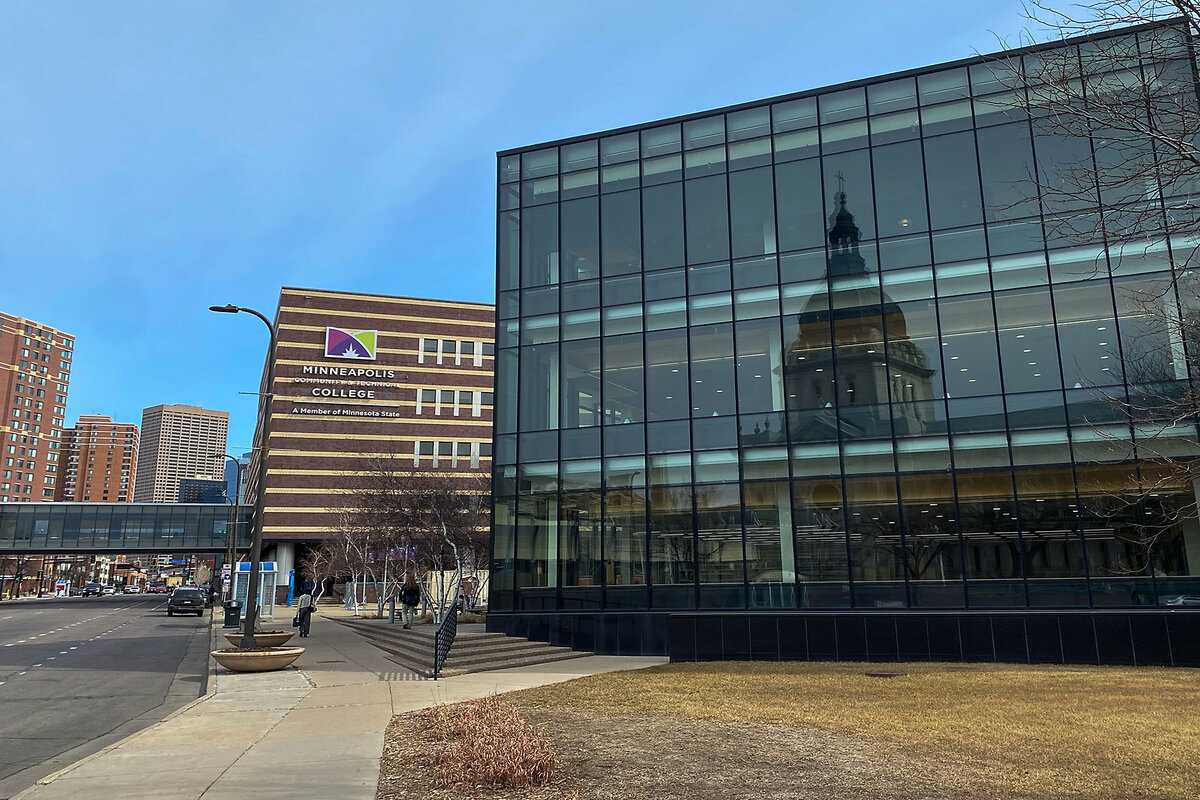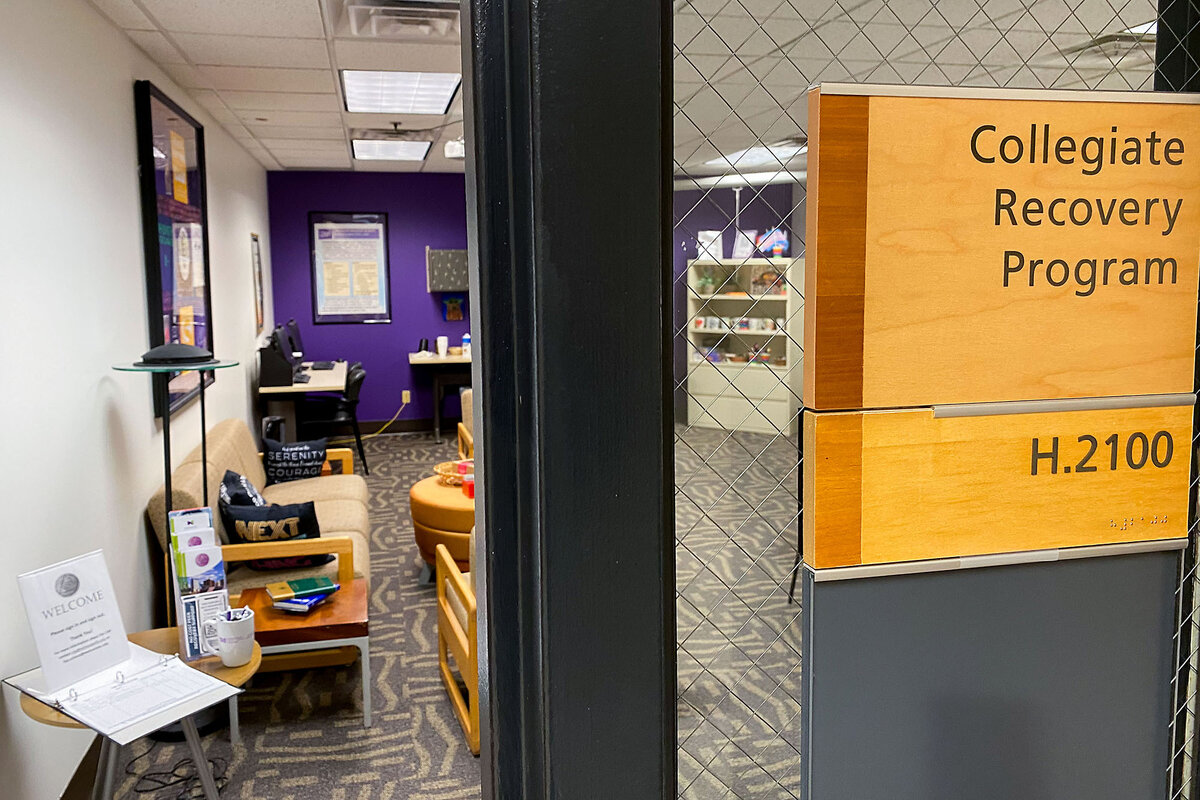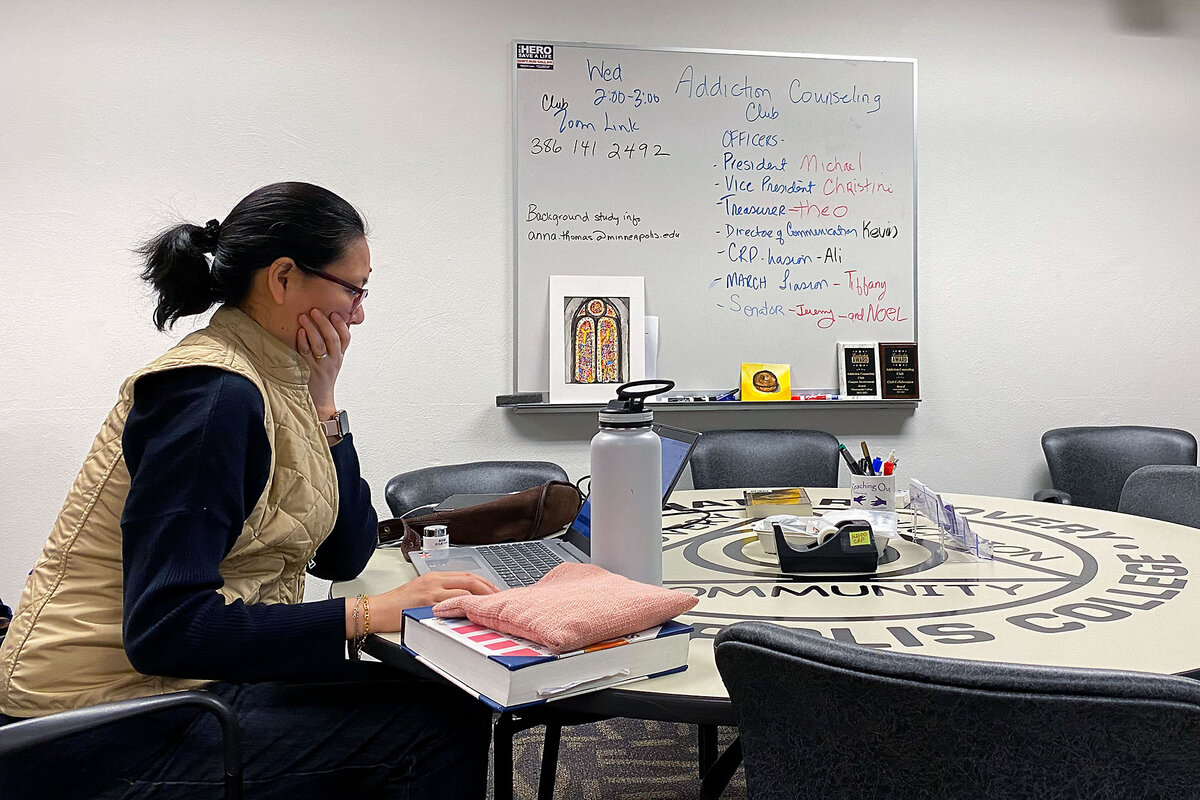With the help of community colleges, students in recovery find a fresh start
| Minneapolis
At a late August meeting in a windowless room at Minneapolis College, a handful of students barely a week into classes sat back on couches, took a breath, and marveled that they were there at all.
“Gifting myself with an education is a part of my recovery,” said Nomi Badboy, age 43, one of three students attending this week’s meeting of the school’s collegiate recovery program. But she admitted to feeling overwhelmed: Her four kids were trying her nerves, her ailing father was requiring more of her time, and a bad-news ex had left her with a destructive puppy and a lingering disbelief that she can pull it all off.
Ray Lombardi, 50, listened thoughtfully. “What I’m hearing is that we have three things in common: It’s hard to be a parent. It’s hard to stay sober. And it’s hard to go back to school as an adult,” he said, adding, “It would be a great tragedy to get sober, get my life in order, and then come here and have college be the cause of going back into using.”
Why We Wrote This
Community colleges are increasingly embracing students who are recovering from substance use disorder, creating programs and tackling challenges like funding and staffing. Their involvement offers a path to access – and second chances.
Collegiate recovery programs began appearing at four-year institutions in the late 1970s, offering services like sober-living dorms, life skills classes, and recovery coaches. Today, more than 170 programs exist across the United States and Canada. But it’s only in the last dozen or so years that programs began popping up at community colleges; Minneapolis College’s program, opened in 2017, was the first in Minnesota and the fifth in the nation.
Today, there are at least 23 recovery programs at community colleges. Their expansion reflects a growing awareness that many survivors of opioid addiction and those who struggled with substance use during the pandemic are now enrolling in pursuit of a fresh start. But despite the need, the programs face significant obstacles, and many are scrambling for dollars and staffing to stay afloat.
Substance use disorder affects about 18% of American adults, according to national statistics. Among 18- to 25-year-olds, the share is nearly 28%. Meanwhile, of the 29 million adults nationwide who said they’ve ever had a problem with substance use, about 72% considered themselves to be in recovery or recovered.
Unlike treatment, a necessary but often short-term process, recovery is the long-term work of rebuilding a healthier and typically sober life. Education is an example of what’s called “recovery capital,” something earned that makes long-term recovery more likely.
Community colleges are a natural first step for people in recovery, says Jessica Miller, who oversees four collegiate recovery programs, including two at community colleges, for the Ten16 Recovery Network, a substance use disorder treatment provider in Central Michigan. At two-year institutions, admission is accessible, tuition is affordable, and flexible coursework fits into schedules complicated not only by jobs and families, but counseling, support groups, and doctor visits.
“I don’t know why we weren’t trying to do this years ago,” she says.
A broader approach to recruitment
In November, the Association of Recovery in Higher Education, which serves as a hub for the programs, launched a working group tasked in part with editing the guidelines for starting recovery programs to make them more applicable to community colleges. A new networking group for community college program coordinators held its first call in February.
Advocates say the growing number of recovery programs makes sense not just for individuals but for community colleges looking to recoup lost students. Since 2010, enrollment at two-year institutions has declined by nearly 40%, as more people have opted to remain in the workforce or head directly to four-year colleges, among other factors.
The downturn has pushed community colleges to broaden their approach to recruitment, resulting in an increase in the number of students requiring more support and services, says Taylor Odle, an assistant professor of education policy studies at the University of Wisconsin-Madison. The schools are pursuing their goals of serving more students, but the additional supports bring higher costs. “The price tag is not the same,” he says.
Schools investing in recovery programs do so without an abundance of research connecting the programs to improved student outcomes. But the data that exists is encouraging, says Noel Vest, an assistant professor of community health sciences at Boston University. A 2014 paper reviewing the impact of recovery programs, mostly at four-year colleges, found lower incidences of relapse for involved students and slightly higher GPAs and graduation rates compared to their peers overall.
Dr. Vest plans to complete a study this summer of five recovery programs, including Minneapolis College’s. He expects the findings to illuminate best practices for the programs and provide an evidence-based foundation for starting more of them. “Right now,” he says, “the data that says we must be doing this just isn’t out there.”
In the interim, advocates for the programs are using creative approaches to keep them alive and growing. At Tompkins Cortland Community College near Ithaca, New York, program leaders have forged connections with student groups on campus whose struggles with substance use might fly under the radar, such as student athletes.
In Central Michigan, the Ten16 Recovery Network is helping its clients enroll in colleges with recovery supports by providing pre-enrollment services at its out-patient treatment facilities. A client might meet with the collegiate recovery program coordinator, for example, to receive counseling about which career paths might be a good fit, and which ones might present obstacles due to the client’s history with addiction and the legal system.
At Skagit Valley College, a two-year institution north of Seattle, Aaron Kirk runs the recovery program for formerly incarcerated students jointly with the school’s Breaking Free Club. (About 60% of people who are incarcerated struggle with substance use disorder, according to the Substance Abuse and Mental Health Services Administration.) In his role, Mr. Kirk has built a relationship with the local drug court, which offers alternative sentences to eligible individuals who commit to treatment for substance use. Typically, the sentences include a work or education component, making Skagit Valley a natural fit.
“Hope for the future”
Genevieve Ward, 42, enrolled at Skagit Valley in the summer of 2021 after spending time in prison on a drug conviction. While taking coursework in human services, she used money earmarked for students in the recovery program to earn certification as a peer recovery coach. She uses the skills daily as a leader in the recovery housing where she lives near campus.
“In school, the number one struggle is that most of us don’t feel like we’re smart enough. That’s what I see the most, and what I feel the most,” she says. She credits the Breaking Free Club with creating the community she and her peers need to beat back their insecurities and succeed in the classroom.
In the years leading up to her incarceration, Ms. Ward says she was living each day simply to survive. “But this college, this club, has given me hope for the future — I know that there is one.” After graduating this spring, she plans to transfer to nearby Western Washington University, where talks are underway to expand recovery supports thanks in part to advocacy from students in the Breaking Free Club. Ultimately, she hopes to land in a career that helps people with struggles like the ones she’s faced.
For many students like Ms. Ward, community colleges’ flexible academic offerings make college possible. But the same flexibility creates obstacles to the success of on-campus groups. Options like part-time course loads, online classes, and short certificate programs can stymie consistent attendance and participation. Even for full-time students, the two-year window creates frequent turnover. “A lot of our work is student-led,” says Mr. Kirk at Skagit Valley. “It’s challenging to have these awesome leaders who graduate so quickly.”
It’s also hard to engage students in recovery programs when they don’t have the time to linger on campus. “These students are flying home from work, making dinner, getting their kids settled, then racing to get over here on time for class,” says Cheryl Kramer, recovery program advisor at Cape Cod Community College, in Massachusetts.
“The need is everywhere”
But the toughest scrambles are often for staff and funding. Jonathan Lofgren, a professor of addiction counseling at Minneapolis College, launched the college’s program in 2017 after a sabbatical year studying recovery on college campuses. School leaders provided a dedicated space for the program and allowed Dr. Lofgren a half day per week to manage it, but they stopped short of hiring a dedicated coordinator.
During the pandemic, the program moved online and participation dropped. Welcome news arrived in 2021, though, when the school won a state grant in collaboration with a nearby four-year university, providing funding for two paid interns, a peer recovery coach, and a coordinator, Lisa Schmid.
But amid a nationwide shortage of staff in the treatment and recovery field, the peer coach and one intern position remain vacant. In November, Ms. Schmid took extended personal leave, which left her role unfilled as well. While she was out, two student workers ensured the recovery program room stayed open, emails went out, and weekly meetings happened. But broader goals, like increasing awareness of recovery support services on campus, lost steam.
When Ms. Schmid returned from leave in February, she prioritized spreading word of the program to likely partners, such as the college’s veteran services program and its admissions team. In March, Minneapolis College leaders reached an agreement with the campus health clinic to continue funding her position once the state grant runs out.
“The need is everywhere,” Ms. Schmid says. Recovery “has always been such a hush-hush thing. How do we normalize it?”
Advocates hope that a percentage of the hundreds of millions of dollars in state opioid settlement funding can be earmarked for collegiate recovery, and that Congress might one day approve additional funding. President Biden’s stalled 2024 budget includes $10.8 billion for the Substance Abuse and Mental Health Services Administration, of which 10% would be set aside for recovery support services.
In a handful of states, legislation has made for a rosier funding picture. Washington lawmakers passed a bill in 2019 that led to the creation of a state grant fund to support recovery. From that work grew the Washington State Collegiate Recovery Support Initiative, which has provided funding for eight colleges, including four community colleges, to open recovery programs or provide recovery services in pre-existing programs, like Skagit Valley’s Breaking Free Club.
Patricia Maarhuis of Washington State University says that, ultimately, collegiate recovery supports are about propelling academic success. “People might say this is just another student group, but no. This is not the frosting; this is the cake. If you want your students to stay in school and do well, you need recovery supports.”
Back in Minneapolis, Ms. Badboy has found a new home for the destructive puppy and her kids are settled in good schools and daycares. She’s thriving in her classes and expects to graduate in 2025. The balancing act of family, school and recovery, for now, is stable.
Recovery is painstakingly hard, she says. But her journey – more than 12 years sober after nine bouts of treatment – has created a firm structure in her life that supports college success as much as it supports her well-being. Her peers in the program understand that in a way few others can, she says, and she feels accountable to them.
“It’s made it so that I really want to do this – almost that I must do this, I have to do this,” she says. “Because other people like me, who’ve felt the same way about themselves, need to see that this is possible.”
This story about collegiate recovery programs was produced by The Hechinger Report, a nonprofit, independent news organization focused on inequality and innovation in education. The piece is also appearing in the MinnPost, in Minneapolis.









